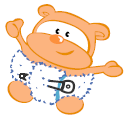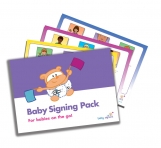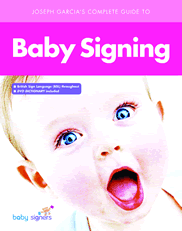It’s older than you think
It may come as some surprise to all those people who think of signing with babies as being very new to find out that it’s actually based upon more than 20 years of research by internationally respected academics.
Having said this, it’s fair to say that it is most certainly an idea whose time has come. The practical experience of the last two decades have now provided us with proven learning programmes, hints and tips to make signing easy and immensely rewarding for parents and babies alike.
The academic approach
While some might point to Werner and Kaplan (1963) as being the first to publish in this area, most people would agree that it is Drs Linda Acredolo and Susan Goodwyn of California University that have contributed most.
In 1982, they noticed that young babies would spontaneously use simple gestures to communicate before they could talk. This prompted them to launch an ongoing research programme that has lasted 20 years and generated a wealth of published research, much of it funded by the US National Institute of Health.
Their findings have laid the foundations for a revolution in the way that mothers communicate with their babies. There have been unexpected benefits too. As well as having a happier, less frustrated baby and a closer bond between parent and child, there are longer-term advantages.
They found that babies that sign learn to talk earlier than non-signing babies. And, when they did talk, they developed larger vocabularies and were more self-confident. This headstart in life didn’t stop there either – babies that used sign language still had significantly higher IQ’s in follow-up research at the age of eight.
Acredolo and Goodwyn are continuing their research in the psychology department at California University but they are by no means alone. New research is being published every week by academics around the world.
The practical approach
But even before Acredolo and Goodwyn started their research in the early 80’s, others were recognising the potential. Most notably, Joseph Garcia noticed how babies could use signs to communicate as early as the 1970’s. His research at Alaska University (1987) found that hearing babies of deaf parents were able to communicate more easily and far earlier than similar babies of hearing parents.
Joseph’s more recent focus has been upon creating a truly practical signing system for babies. Now generally regarded as the world’s leading authority on baby signing, he was able to draw upon his background as a sign language interpreter with the deaf community and upon his doctoral studies in adult learning and education as well his own first hand experiences to write the world’s leading baby signing program – Sign With Your Baby. More recently he’s written a brand new book, Joseph Garcia’s complete Guide to Baby Signing, that extends those original principles by providing hands-on guidance on how to use baby signing in a wide range of day-to-day situations. ‘ This is due for publication in early 2005.’
Joseph’s outstanding success stems from the clarity and ease of his teaching techniques and his adoption of standard sign language signs as used by the Deaf (some other writers, most notably Acredolo and Goodwyn, suggest parent and baby develop home-made symbols between them). The results of his work are simple, straightforward and proven in practise by countless parents around the world.
Research References and Further Reading
Recommended for all levels
Garcia, Dr Joseph, Joseph Garcia’s Complete Guide to Baby Signing (Babysigners, London 2005)
Baby signing general background
Acredolo, Linda. and Goodwyn, Susan, Baby Signs (Vermillion, London, 2000)
Daniels, Dr Marilyn, Dancing with Words: Signing for Hearing Children’s Literacy
(Bergin & Garvey, Westport, Connecticut 2001)
Smith, Cath, Signs Make Sense (Souvenir Press, London 1990)
Ward, Dr Sally, Baby Talk (Arrow Books, London 2004)
Accelerates speech in babies
L.P. Acredolo & S.W. Goodwyn, ‘Furthering our understanding of what humans understand’ in Human Development, 40, pp. 25-31 (1997)
S.W. Goodwyn & L.P. Acredolo, ‘Symbolic gesture versus word: Is there a modality advantage for onset of symbol use?’ in Child Development, 64, pp. 688-701 (1993)
B. Moore, L.P. Acredolo & S.W. Goodwyn, ‘Symbolic gesturing and joint attention: Partners in facilitating verbal development’ Paper presented at the Biennial Meetings of the Society for Research in Child Development (April 2001)
A greater written and spoken vocabulary
M. Daniels, ‘The effects of sign language on hearing children’s language development’ in Communication Education, 43, pp. 291-298 (October, 1994a)
M. Daniels, ‘Seeing Language: The Effect Over Time of Sign Language on Vocabulary Development in Early Childhood Education’ in Child Study Journal, 26, pp. 193-208 (1996)
L. Felzer, ‘A Multisensory Reading Program That Really Works’ in Teaching and Change, 5, pp. 169-183 (1998)
J. Hafer, Signing for Reading Success. (Washington D.C.: Clerc Books, Gallaudet University Press, 1986)
L. Koehler and L. Loyd, ‘Using Finger Spelling/Manual Signs to Facilitate Reading and Spelling’ Biennial Conference of the International Society for Augmentative and Alternative Communication (4 th Cardiff Wales, September 1986)
R. Wilson, J. Teague, and M. Teague, ‘The Use of Signing and Fingerspelling to Improve Spelling Performance with Hearing Children’ in Reading Psychology, 4, pp. 267-273 (1985)
A higher IQ
L.P Acredolo & S.W Goodwyn, ‘The long-term impact of symbolic gesturing during infancy on IQ at age 8’ in Paper presented at the meetings of the International Society for Infant Studies (Brighton, UK, July 2000)
S.W. Goodwyn, L.P. Acredolo & C. Brown, ‘Impact of Symbolic Gesturing on Early Language Development’ in Journal of Nonverbal Behaviour, 24, pp. 81-103 (2000)
B. Moore, L.P. Acredolo, & S.W. Goodwyn, ‘Symbolic gesturing and joint attention: Partners in facilitating verbal development’ in Paper presented at the Biennial Meetings of the Society for Research in Child Development (April 2001)
Increased brain activity
D. Bavelier, D. P. Corina and H.J. Neville, ‘Brain and Language: a Perspective from Sign Language’ in Neuron, Vol 21, pp. 275-278 (Cell Press, August 1998)
W.H. Calvin and G.A. Ojemann,. Inside the Brain: Mapping the Cortex, Exploring the Neuron (New American Library, 1980).
Baby signing in a baby’s development
L.P. Acredolo and S.W. Goodwyn ‘Symbolic gesturing in normal infants’ in Child Development, 59, pp. 450-466 (1988)
L.P. Acredolo and S.W. Goodwyn ‘The significance of symbolic gesturing for understanding language development’ in R. Vasta (Ed.), Annals of Child Development, 7, pp. 1-42. (London: Jessica Kingsley Publishers, 1990)
L. Acredolo, S. Goodwyn, K. Horobin, and Y. Emmons, ‘The signs and sounds of early language development’ in L. Balter & C. Tamis-LeMonda (Eds.), Child Psychology: A Handbook of Contemporary Issues pp. 116 – 139 (New York: Psychology Press, 1999)
S. Goodwyn and L. Acredolo, ‘Encouraging symbolic gestures: Effects on the relationship between gesture and speech’ in J. Iverson & S. Goldin-Meadows (Eds.) The nature and functions of gesture in children’s communication, pp. 61-73. (San Francisco: Jossey-Bass, 1998)
P.L. Griffith, ‘Mode switching and mode-finding in a hearing child of deaf parents’ in Sign Language Studies, 48, pp. 195-222. (1985)
Karmiloff-Smith, A ‘The extraordinary journey from foetus through infancy.’ In Journal of Child Psychology and Psychiatry, 36, pp 1,293-1,315 (1995)
R. Wilbur and M. Jones, ‘Some aspects of the acquisition of American Sign Language and English by three hearing children of deaf parents’ in La Galy, Fox & Bruck (Eds), Papers from the Tenth Regional Meeting of the Chicago Linguistic Society (1974)
Apraxia of Speech
P.A. Square, ‘Treatment Approaches For Developmental Apraxia Of Speech’ in Clinical Communication Disorders, Sept; 4(3): 151-61 (1994)
S. Gretz, ‘Using Sign Language with Children Who Have Apraxia of Speech’ www.apraxia-kids.org/topics/sign.html.
Autism
Stephen M. Edelson, PhD Centre for the Study of Autism, Salem, Oregon
Dr Edelson’s articles is available online at www.autism.org/sign.html.
Down Syndrome
M.R. Hopmann, ‘The Use of Signs by Children with Downs Syndrome’ in Down Syndrome Today Vol 2, No. 2, pp. 22-3 (1993)
C-LP. Donovan, ‘Teaching Sign Language’ in Disability Solutions Vol 2, Issue 5 (January/February 1998)
J.F. Miller, A. Sedey, G. Miolo, M. Rosin, J. Murray-Branch ‘Vocabulary acquisition in young children with Down Syndrome: Speech and sign’ in Paper presented at the 9 th World Congress of the International Association for the Scientific Study of Mental Deficiency (Queensland, Australia, August 1992)
E.D. Gibbs, A.S. Springer, S.C. Cooley & S. Aloisio ‘Early use of total communication: Patterns across eleven children with Down Syndrome’ in Paper presented at the meeting of the International Early Childhood Conference on Children with Special Needs (St. Louis, MO, November 1991)
Reading Disabilities
D. Blackburn, J. Vonvillian, and R. Ashby ‘Manual Communication as an Alternative Mode of Language Instruction for Children with Severe Reading Disabilities’ in Language, Speech and Hearing Services in Schools, 15, pp. 22,-31 (January 1984)
J. Carney, G. Cioffi, and W. Raymond ‘Using Sign Language for Teaching Sight Words’ in Teaching Exceptional Children, pp. 214-217 (Spring 1985)
M. Vernon, J. Coley, J. Hafer and J. Dubois ‘Using Sign Language to Remediate Severe Reading Problems’ in Journal of Learning Disabilities 13, pp. 215-218. (April 1980)
L. Sensenig, B. Topf, and E. Mazeika ‘Sign Language Facilitation of Reading with Students Classified as Trainable Mentally Handicapped’ in Education and Training of the Mentally Retarded pp. 121-125. (June 989)




